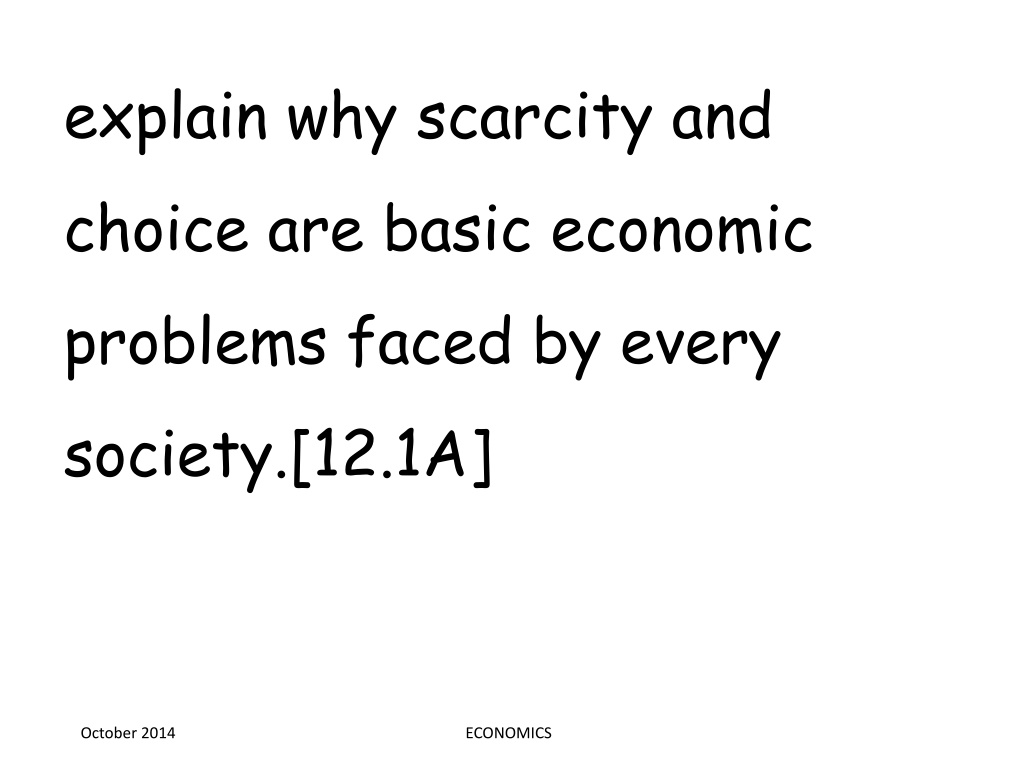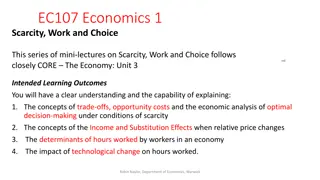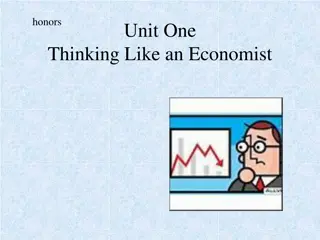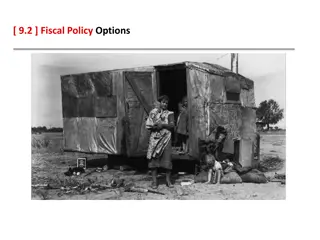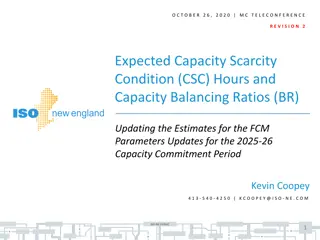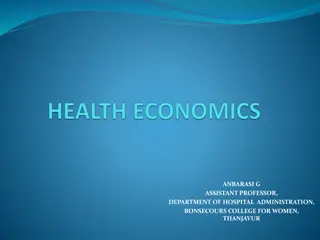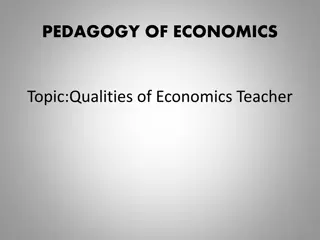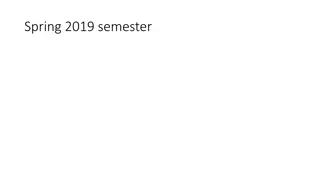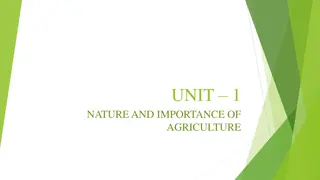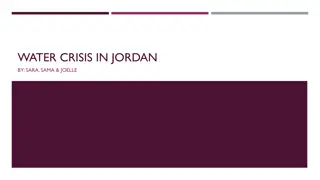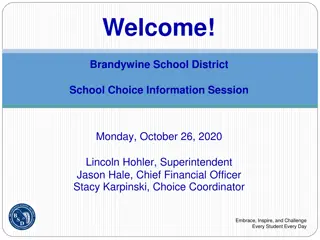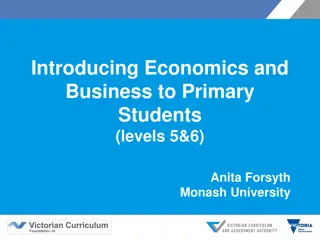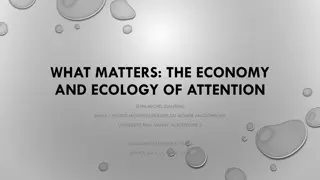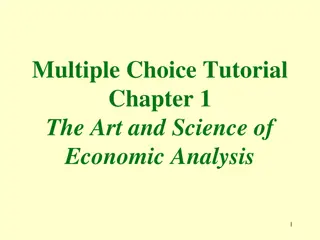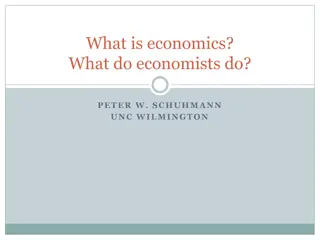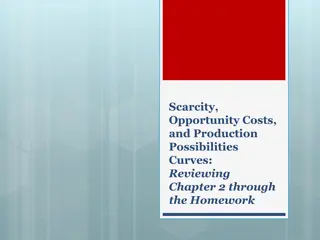Scarcity and Choice in Economics
Scarcity and choice are fundamental economic issues faced by all societies. They stem from limited resources and unlimited wants, leading to the need for decision-making. Societies address economic questions by allocating resources through production factors. Production possibilities curves show opportunity costs and scarcity effects. Changes in price affect demand and supply, with non-price determinants creating shifts. Understanding absolute and comparative advantages helps explain trade patterns. The impact of imports, exports, free trade, and trade barriers on economies is analyzed.
Download Presentation

Please find below an Image/Link to download the presentation.
The content on the website is provided AS IS for your information and personal use only. It may not be sold, licensed, or shared on other websites without obtaining consent from the author.If you encounter any issues during the download, it is possible that the publisher has removed the file from their server.
You are allowed to download the files provided on this website for personal or commercial use, subject to the condition that they are used lawfully. All files are the property of their respective owners.
The content on the website is provided AS IS for your information and personal use only. It may not be sold, licensed, or shared on other websites without obtaining consent from the author.
E N D
Presentation Transcript
explain why scarcity and choice are basic economic problems faced by every society.[12.1A] October 2014 ECONOMICS
describe how societies answer the basic economic questions.[12.1B] October 2014 ECONOMICS
describe the economic factors of production.[12.1C] October 2014 ECONOMICS
interpret a production- possibilities curve and explain the concepts of opportunity costs and scarcity.[12.1D] October 2014 ECONOMICS
understand the effect of changes in price on the quantity demanded and quantity supplied.[12.2A] October 2014 ECONOMICS
identify the non-price determinants that create changes in supply and demand, which result in a new equilibrium price.[12.2B] October 2014 ECONOMICS
interpret a supply-and-demand graph using supply-and- demand schedules.[12.2C] October 2014 ECONOMICS
explain the concepts of absolute and comparative advantages.[12.3A] October 2014 ECONOMICS
apply the concept of comparative advantage to explain why and how countries trade.[12.3B] October 2014 ECONOMICS
analyze the impact of U.S. imports and exports on the United States and its trading partners.[12.3C] October 2014 ECONOMICS
compare the effects of free trade and trade barriers on economic activities.[12.4A] October 2014 ECONOMICS
evaluate the benefits and costs of participation in international free-trade agreements.[12.4B] October 2014 ECONOMICS
analyze the effects of changes in exchange rates on imports and exports.[12.4C] October 2014 ECONOMICS
describe the basic characteristics of economic systems, including property rights, incentives, economic freedom, competition, and the role of government.[12.5A] October 2014 ECONOMICS
compare the free enterprise system, socialism, and communism using the basic characteristics of economic systems.[12.5B] October 2014 ECONOMICS
examine current examples of free enterprise, socialist, and communist economic systems.[12.5C] October 2014 ECONOMICS
understand that the terms free enterprise, free market, and capitalism are synonymous terms to describe the U.S. economic system.[12.5D] October 2014 ECONOMICS
analyze the importance of various economic philosophers, including Friedrich Hayek, Milton Friedman, John Maynard Keynes, and Adam Smith, and their impact on the U.S. free enterprise system.[12.5E] October 2014 ECONOMICS
explain the basic characteristics of the U.S. free enterprise system, including private property, incentives, economic freedom, competition, and the limited role of government.[12.6A] October 2014 ECONOMICS
explain the benefits of the U.S. free enterprise system, including individual freedom of consumers and producers, variety of goods, responsive prices, investment opportunities, and the creation of wealth.[12.6B] October 2014 ECONOMICS
analyze recent changes in the basic characteristics of the U.S. economy.[12.6C] October 2014 ECONOMICS
analyze the costs and benefits of U.S. economic policies related to the economic goals of economic growth, stability, full employment, freedom, security, equity (equal opportunity versus equal outcome), and efficiency.[12.6D] October 2014 ECONOMICS
analyze the costs and benefits of the purchase, use, or disposal of personal and business property.[12.7A] October 2014 ECONOMICS
identify and evaluate examples of restrictions that the government places on the use of business and individual property.[12.7B] October 2014 ECONOMICS
interpret the roles of resource owners and firms in a circular-flow model of the economy and provide real- world examples to illustrate elements of the model.[12.8A] October 2014 ECONOMICS
explain how government actions affect the circular- flow model.[12.8B] October 2014 ECONOMICS
explain how the circular-flow model is affected by the rest of the world.[12.8C] October 2014 ECONOMICS
describe characteristics and give examples of pure competition, monopolistic competition, oligopoly, and monopoly.[12.9A] October 2014 ECONOMICS
identify and evaluate ordinances and regulations that apply to the establishment and operation of various types of businesses.[12.9B] October 2014 ECONOMICS
interpret economic data, including unemployment rate, gross domestic product, gross domestic product per capita as a measure of national wealth, and rate of inflation.[12.10A] October 2014 ECONOMICS
analyze business cycles using key economic indicators.[12.10B] October 2014 ECONOMICS
analyze how productivity relates to growth.[12.11A] October 2014 ECONOMICS
analyze how technology relates to growth.[12.11B] October 2014 ECONOMICS
analyze how trade relates to growth.[12.11C] October 2014 ECONOMICS
describe the functions of money.[12.12A] October 2014 ECONOMICS
describe the characteristics of money, including commodity money, fiat money, and representative money.[12.12B] October 2014 ECONOMICS
examine the positive and negative aspects of barter, currency, credit cards, and debit cards.[12.12C] October 2014 ECONOMICS
explain the structure of the Federal Reserve System.[12.13A] October 2014 ECONOMICS
analyze the three basic tools used to implement U.S. monetary policy, including reserve requirements, the discount rate and the federal funds rate target, and open-market operations.[12.13B] October 2014 ECONOMICS
explain how the actions of the Federal Reserve System affect the nation's money supply.[12.13C] October 2014 ECONOMICS
analyze the decline in value of the U.S. dollar, including the abandonment of the gold standard.[12.13D] October 2014 ECONOMICS
identify economic concepts in the U.S. Constitution, including property rights and taxation.[12.14A] October 2014 ECONOMICS
describe the role of government in the U.S. free enterprise system and the changes in that role over time.[12.14B] October 2014 ECONOMICS
evaluate government rules and regulations in the U.S. free enterprise system.[12.14C] October 2014 ECONOMICS
identify types of taxes at the local, state, and national levels and the economic importance of each.[12.15A] October 2014 ECONOMICS
analyze the categories of revenues and expenditures in the U.S. federal budget.[12.15B] October 2014 ECONOMICS
analyze the impact of fiscal policy decisions on the economy.[12.15C] October 2014 ECONOMICS
explain the characteristics of sole proprietorships, partnerships, and corporations.[12.16A] October 2014 ECONOMICS
analyze the advantages and disadvantages of sole proprietorships, partnerships, and corporations.[12.16B] October 2014 ECONOMICS
analyze the economic rights and responsibilities of businesses, including those involved in starting a small business.[12.16C] October 2014 ECONOMICS
